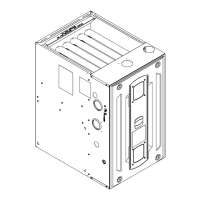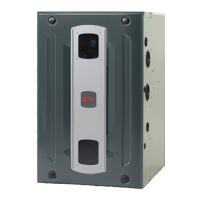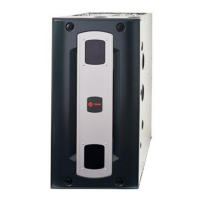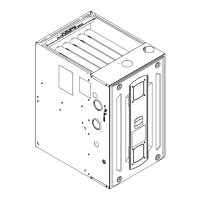42
S9V2-SVX001-1B-EN
Furnace
Air
Inlet
Vent
Attic
Vent
(See Note)
Attaching Vent Piping
VVEENNTT FFIITTTTIINNGG MMAATTEERRIIAALL –– PPLLAASSTTIICC
Gas and liquid tight single wall vent fittings, designed
for resistance to corrosive flue condensate, MUST be
used throughout.
Listed in the Approved Vent Pipe Materials table are
designations for different types of 2" and 3" size pipe
and fittings that meet these requirements. The
materials listed are various grades of PVC, CPVC, ABS,
PolyPro® by DuraVent , Z-Dens by Novaflex Group,
Innoflue® by Centrotherm, ECCO™ polypropylene
venting system, and PolyFlue™ polypropylene venting
systems.
IImmppoorrttaanntt:: Products installed in Canada must use vent
systems that are certified to the Standard
for Type BH Gas Venting Systems (ULC
S636) for Class II-A venting systems (up to
65°C). Components of the vent system
must not be interchanged with other vent
systems or unlisted pipe or fittings. Plastic
components, specified primers, and glues
must be from a single system manufacturer
and not intermixed with other system
manufacturer's vent system parts. In
addition, the first three feet of the vent pipe
must be visible for inspection.
PIPE JOINTS: All joints must be fastened and sealed
per manufacturer instructions and local and national
codes to prevent escape of combustion products into
the building.
MMAANNUUFFAACCTTUURREEDD MMOODDUULLAARR VVEENNTTIINNGG SSYYSSTTEEMMSS
WWAARRNNIINNGG
CCAARRBBOONN MMOONNOOXXIIDDEE PPOOIISSOONNIINNGG
HHAAZZAARRDD!!
FFaaiilluurree ttoo ffoollllooww tthhiiss WWaarrnniinngg mmaayy rreessuulltt iinn
pprrooppeerrttyy ddaammaaggee,, sseevveerree ppeerrssoonnaall iinnjjuurryy,, oorr
ddeeaatthh..
SSeeee tthhee AApppprroovveedd VVeenntt PPiippee MMaatteerriiaallss ttaabbllee ffoorr
mmaannuuffaaccttuurreedd mmoodduullaarr vveennttiinngg ssyysstteemmss tthhaatt aarree
aapppprroovveedd ffoorr uussee wwiitthh tthhiiss pprroodduucctt.. FFoollllooww tthhee
mmaannuuffaaccttuurreerr’’ss iinnssttaallllaattiioonn iinnssttrruuccttiioonnss wwhheenn
iinnssttaalllliinngg tthhee vveennttiinngg ssyysstteemm..
WWAARRNNIINNGG
CCAARRBBOONN MMOONNOOXXIIDDEE PPOOIISSOONNIINNGG
HHAAZZAARRDD!!
FFaaiilluurree ttoo ffoollllooww tthhiiss WWaarrnniinngg mmaayy rreessuulltt iinn
pprrooppeerrttyy ddaammaaggee,, sseevveerree ppeerrssoonnaall iinnjjuurryy,, oorr
ddeeaatthh..
DDoo nnoott uussee cceemmeenntt oonn ppoollyypprrooppyylleennee vveennttiinngg
ssyysstteemmss.. FFoollllooww tthhee mmaannuuffaaccttuurreerr’’ss iinnssttaallllaattiioonn
iinnssttrruuccttiioonnss wwhheenn iinnssttaalllliinngg tthhee vveennttiinngg ssyysstteemm..
For manufactured modular venting systems that are
approved with this product see PVC vent fitting
material table. Do not drill into polypropelene venting
pipes
BBOONNDDIINNGG OOFF PPVVCC
NNoottee:: It is recommended that the first joints from the
Furnace be connected and sealed with high
temperature RTV. This will enable the pipes to be
removed later without cutting.
Be sure to properly support these joints.
Commercially available solvent cement for PVC must
be used to join PVC pipe fittings. Follow instructions on
container carefully.
Pipe and Fitting – ASTM D1785, D2466, D2661, & D2665
PVC Primer and Solvent Cement – ASTM D2564
Procedure for Cementing Joints – Ref ASTM D2855
1. Cut pipe square, remove ragged edges and burrs.
Chamfer end of pipe, then clean fitting socket and
pipe joint area of all dirt, grease, moisture or chips.
2. After checking pipe and socket for proper fit, wipe
socket and pipe with cleaner-primer. Apply a liberal
coat of primer to inside surface of socket and
outside of pipe.
DO NOT ALLOW PRIMER TO DRY BEFORE
APPLYING CEMENT.
3. Apply a thin coat of cement evenly in the socket.
Quickly apply a heavy coat of cement to the pipe
end and insert pipe into fitting with a slight twisting
movement until it bottoms out.
FFuurrnnaaccee GGeenneerraall IInnssttaallllaattiioonn

